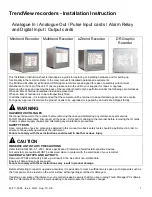
USB-2416 User's Guide
Functional Details
16
Noise filtering, data rate, and throughput rate
Although the USB-2416 A/D converter has a maximum data rate of 3,750 S/s, the actual throughput rate you
observe for voltage and temperature data is determined by these formulas.
Maximum single-channel throughput:
s
rate
data
µ
640
1
1
+
Maximum multiple-channel throughput:
∑
+
n
μs
640
rate
data
1
1
where n is the number of channels
See Table 18 and Table 19 in the Specifications chapter for details.
This drop-off in throughput rate is due to the USB-2416's noise filtering feature. You can control the amount of
the noise filtering by adjusting the data rate setting. By reducing the data rate, the averaging of samples
increases, and noise drops correspondingly.
Figure 10 illustrates this inverse relationship. This graph applies to the A/D converter only—do not expect this
level of performance from the USB-2416 itself.
Figure 10. USB-2416 A/D converter data rate vs. noise graph
If low noise is your main concern, you can operate the USB-2416 at very low data rates starting from 2.5 S/s. At
low rates, much of the noise is averaged out of the data, and issues such as reference noise become less
important.
At higher data rates, higher-frequency noise sources are not averaged out and begin to be troublesome. These
noise sources include the noise inherent in the A/D converter itself, which is not reducible.
Since thermocouples can pick up noise in your environment, select a data rate based on the primary noise
frequency. For example, to reduce the effect of 60 Hz noise, select a data rate of 60 (or a sub-multiple of 60,
such as 10 or 20).
Multiple-channel throughput rates
When setting different sample rates for different channels, be aware that the all channels will be sampled within
the same sample window based on the channel with the lowest sample rate.
For example, if you set a 10 Hz data rate for channel 0, and a 50 Hz data rate for channel 1, basically, both
channels pass the same number of samples per second to the host computer. However, more averaging is
performed on channel 0's samples; therefore, channel 0 is sampled at a higher resolution.
The USB-2416's A/D converter performs averaging, and the number of averages equals 30,000/data rate.
















































